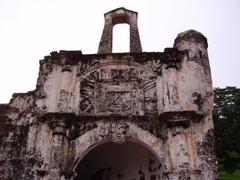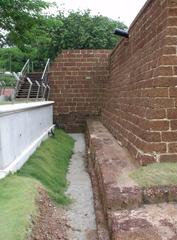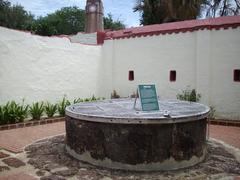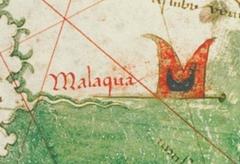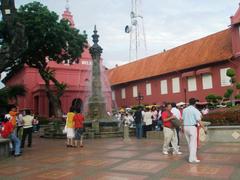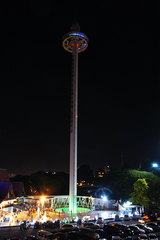Baba & Nyonya Heritage Museum Melaka: Visiting Hours, Tickets, and Comprehensive Guide
Date: 04/07/2025
Introduction
The Baba & Nyonya Heritage Museum in Melaka, Malaysia, stands as a vibrant testament to the multicultural legacy of the Peranakan, or Straits Chinese, community. Established in 1985 by the Chan family—direct descendants of the original owners—the museum preserves the unique blend of Chinese, Malay, and European influences that define Peranakan identity. Housed in a meticulously restored 19th-century townhouse on “Millionaire’s Row” (Jalan Tun Tan Cheng Lock), the museum invites visitors to immerse themselves in the architecture, traditions, and daily life of Melaka’s Peranakan society (Baba Nyonya Heritage Museum; Malaysiakini).
This guide details the museum’s history, cultural significance, architectural highlights, visiting hours, ticketing, accessibility, and nearby attractions—providing all you need to plan a rewarding visit.
Table of Contents
- Origins of the Baba Nyonya Community
- Museum History and Establishment
- Architectural and Artistic Heritage
- Cultural Significance and Community Identity
- Museum Collections and Exhibitions
- Visitor Information (Hours, Tickets, Accessibility, Tours)
- Practical Visitor Tips (Getting There, Facilities, Dining, Accommodation)
- Nearby Melaka Attractions
- Frequently Asked Questions (FAQ)
- Summary and Travel Tips
- References
Origins of the Baba Nyonya Community
The Baba Nyonya, or Peranakan Chinese, community emerged in Melaka between the 15th and 16th centuries as Chinese traders from Fujian intermarried with local Malay women. Their descendants—Babas (male) and Nyonyas (female)—nurtured a distinct cultural identity that harmonized Chinese, Malay, and, later, colonial European influences. This syncretic culture is reflected in language, cuisine, rituals, and material heritage lingering in Melaka today (Malaysiakini; China Daily HK).
Museum History and Establishment
Located at 48-50 Jalan Tun Tan Cheng Lock, the museum occupies three interconnected townhouses acquired by the Chan family in 1861 and expanded in 1896. “Millionaire’s Row” is renowned for its grand residences, emblematic of the wealth and social standing of Melaka’s Peranakan elite (Wonderful Malaysia). The museum opened to the public in 1985 under the stewardship of Chan Kim Lay, preserving the family’s legacy and the broader Peranakan narrative (The Travel Shots; Baba Nyonya Heritage Museum).
Architectural and Artistic Heritage
The museum’s architecture is a living exhibit of Peranakan artistry and cosmopolitan taste:
- Elaborate Woodwork: Hand-carved doors and staircases in cengal wood, with intricate floral and geometric motifs.
- Porcelain and Tiles: Imported Chinese tiles and European ceramics adorn floors and walls.
- Open Courtyards: Central courtyards enhance ventilation and serve as social spaces.
- European Influences: Dutch and Portuguese features, such as stained glass and colonial furniture, blend with Asian aesthetics (Malaysia GoTo; Wonderful Malaysia).
Cultural Significance and Community Identity
The museum is more than a collection of artifacts—it’s a guardian of intangible Peranakan heritage.
- Language: Baba Malay, a creole of Malay, Hokkien, and English.
- Cuisine: Signature dishes like Otak-Otak and Ayam Buah Keluak, with utensils and recipe books on display (The Travel Shots).
- Fashion: The Nyonya kebaya, a symbol of Peranakan femininity, with ornate embroidery and beadwork.
- Rituals: Ancestral worship and syncretic celebrations blending Chinese and local traditions (China Daily HK).
Through educational programs, tours, and interactive events, the museum fosters appreciation and continuity of Peranakan identity (Malaysia GoTo).
Museum Collections and Exhibitions
Permanent Collections
- Furniture: Opulent teak and rosewood cabinets, mother-of-pearl inlay, and colonial-era chairs.
- Traditional Costumes: Hand-embroidered kebaya, batik sarongs, and ceremonial attire.
- Jewelry: Gold, silver, and beaded accessories such as kerongsang and hairpins.
- Porcelain: Chinese famille rose ceramics and daily wares.
- Family Archives: Historic photographs, letters, and legal documents trace the Chan family lineage (Onalulu).
Thematic Displays
- Reception Hall: Tok Panjang (long table) set for festive dining.
- Bridal Chamber: Qing-style wedding beds and marital artifacts.
- Kitchen: Traditional implements, spice racks, and culinary memorabilia.
Rotating Exhibitions
- Textile and beadwork showcases.
- Culinary heritage events with cooking demonstrations.
- Contemporary art and photography exhibits interpreting Peranakan culture.
Visitor Information
Visiting Hours
- Weekdays (except Tuesday): 10:00 AM – 4:15 PM
- Weekends: 10:00 AM – 4:45 PM
- Closed on Tuesdays
- Last admission: 30 minutes before closing (Baba Nyonya Heritage Museum)
Ticket Prices
- Adults: RM 25
- Children: RM 15
- Traditional costume experience: RM 100
- Guided tours: Additional fee (~RM 25 per person)
- Tickets available at the entrance or online
Accessibility
- Wheelchair access is available to some sections, but narrow staircases and uneven floors may limit mobility.
- Restrooms and a gift shop are on-site.
Guided Tours
- Offered in English, Malay, and Mandarin.
- Led by knowledgeable guides, often descendants of the Chan family.
- Self-guided resources (downloadable in multiple languages) are also available (Baba Nyonya Heritage Museum).
Practical Visitor Tips
Getting There
- By Car: About 2 hours from Kuala Lumpur; parking available nearby.
- By Bus: Buses from KL/Singapore to Melaka Sentral; taxis and Grab to the museum.
- On Foot: Walking distance from Jonker Street and Dutch Square.
Facilities
- Restrooms
- Gift shop with books and Peranakan crafts
- No café inside, but many eateries nearby
Dining & Local Cuisine
- Try Nyonya Laksa, Ayam Buah Keluak, Cendol, and Chicken Rice Balls at Jonker Street eateries (Klook).
Accommodation
- Options range from boutique hotels (e.g., Liu Men Melaka) to international chains (e.g., Holiday Inn Melaka), all within walking distance (Klook).
Travel Tips
- Weekday mornings are less crowded.
- Respectful attire is encouraged.
- Book ahead during holidays or for group tours.
- English is widely spoken by staff.
Nearby Melaka Attractions
Explore Melaka’s UNESCO-listed heritage zone with these highlights:
- Jonker Street: Night market, antiques, and street food (The Simple Travel).
- Dutch Square: Iconic red buildings, Stadthuys, Christ Church (Travel + Leisure Asia).
- A Famosa Fort & St. Paul’s Hill: Portuguese ruins and panoramic city views.
- Cheng Hoon Teng Temple: Malaysia’s oldest Chinese temple.
- Kampung Kling Mosque: Unique blend of Sumatran, Chinese, and Malay architecture (Audiala).
- Melaka Straits Mosque: Floating mosque with stunning sunset views.
- Melaka River Cruise: Scenic journey through the historic heart of the city.
- Family-friendly: Melaka Zoo, Wonderland Theme Park.
Frequently Asked Questions (FAQ)
Q: What are the Baba & Nyonya Heritage Museum visiting hours?
A: 10:00 AM to 4:15 PM on weekdays (except Tuesday); 10:00 AM to 4:45 PM on weekends.
Q: How do I purchase tickets?
A: Buy at the entrance or via the official website.
Q: Is the museum wheelchair accessible?
A: Some sections are accessible, but narrow stairs and historic features may pose challenges.
Q: Are guided tours available?
A: Yes, in English, Malay, and Mandarin; book in advance for best availability.
Q: What other historical sites are nearby?
A: Jonker Street, Dutch Square, A Famosa, St. Paul’s Hill, Cheng Hoon Teng Temple, and more.
Q: Can I take photographs inside?
A: Photography is permitted in most areas; flash and tripods may be restricted. Costume photography incurs an extra fee.
Summary and Travel Tips
The Baba & Nyonya Heritage Museum offers an invaluable window into the Peranakan world of Melaka. Through authentic architecture, curated collections, and interactive experiences, visitors gain insight into the community’s language, cuisine, fashion, and rituals. Its central location in Melaka’s UNESCO World Heritage area allows seamless exploration of nearby attractions and cultural sites. Visitors are encouraged to plan ahead, enjoy local cuisine, and use resources such as the Audiala app for guided tours and updated information.
For a deeper journey into Melaka’s Peranakan and colonial heritage, combine your museum visit with strolls along Jonker Street, river cruises, and tastings at renowned local restaurants. Respectful attire, early weekday visits, and advance bookings (especially for tours) are recommended for a comfortable and enriching experience (Wonderful Malaysia; Klook; Baba Nyonya Heritage Museum).
References
- Baba Nyonya Heritage Museum
- Malaysiakini
- China Daily HK
- Wonderful Malaysia
- Onalulu
- The Travel Shots
- Klook
- The Local Travel Guide
- Travel + Leisure Asia
- The Simple Travel
- Audiala
- Hobbymart
